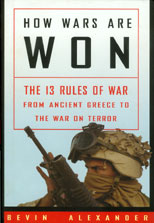 Click here to purchase from Barnes & Noble.
Click here to purchase from Amazon.com.
Click here to purchase from Barnes & Noble.
Click here to purchase from Amazon.com.
Frederick the Great’s “Oblique Order” of Attack
Excerpt from How Wars Are Won: The 13 Rules of War—From Ancient Greece to the War on Terror, by Bevin Alexander, pages 238-40
The armies of eighteenth century Europe were largely mercenary, employed by kings who used military means and diplomacy to advance their own narrow dynastic interests, and who evoked few sentiments of nationalism or patriotism among their subjects. This was a cynical age, and the hired armies were the most cynical of all, composed of the dregs of society, subjected to ferocious discipline, and kept separate from the civilian population because they were so vicious. Officers were afraid to allow soldiers any freedom, lest they desert. As Frederick [the Great of Prussia] himself commented, “If my soldiers began to think, not one would remain in the ranks” because conditions were so bad. Frederick also asserted that a soldier “must be more afraid of his officers than of the dangers to which he is exposed.”
Such armies moved slowly because they were tied to the nearest magazine or supply base for food and other needs. And since such armies were expensive, kings hated to consume them too liberally in combat. Hence the zenith of generalship in this period was not battle but being able to maneuver an enemy away from his supplies, thus forcing him to retreat. In this environment, armies kept close to their magazines, marched very short distances in a day, and paid only passing attention to what should have been the key to their fighting effectiveness, the rate of fire their soldiers could achieve with their muskets. Rate of fire was all-important in actual battle, and it depended upon how quickly soldiers could load, aim, and discharge their single-shot muskets.
Frederick understood this. His army already emphasized discipline to a greater degree than any army in Europe, but he instituted three changes that turned it into a vastly superior force. He trained his soldiers to march faster and farther. He also trained them to fire their muskets at a higher rate than soldiers in other armies. And he emphasized mobile artillery drawn by horses at a time when other armies paid mobility little heed. Thus in three ways, rate of march, rate of firing, and mobile field guns, Frederick’s army was superior to the other armies of the period.
Although most generals sought only to maneuver on their enemy’s rear and avoid battles, occasionally they decided to fight. Such battles were ordinarily head-on collisions because a general determined to confront his enemy usually had time to prevent him from maneuvering on his flank---since armies marched so slowly. That is, a general could normally block a turning movement by stepping directly into the enemy’s path. These head-to-head battles were not usually decisive.
Frederick’s three improvements to his army led him to devise a new method of combat, which turned orthodox practice on its head. Since Frederick’s army marched faster than his enemies, he could move against one of his enemy’s flanks, and attack it before his enemy could change front. This could bring, not a drawn battle, as was so common, but total defeat. Other armies couldn’t copy this tactic because they marched too slowly.
Frederick called his technique the “oblique order,” and he explained it as follows: a commander should strengthen one wing of his army and employ it to attack the enemy flank, while holding back another, smaller wing to threaten the enemy’s main force and keep it from changing position. Since the enemy army would already be deployed, it could not switch troops fast enough to the threatened flank before Frederick’s columns struck. Frederick said an army of 30,000 could beat an army of 100,000 using this method.
The tactic was an adaptation of Epaminondas’s simple technique at Leuctra [in 371 B.C. in Greece], and this simple idea preserved Frederick’s kingdom.
<< More 'Early Wars' Excerpts << Back to top